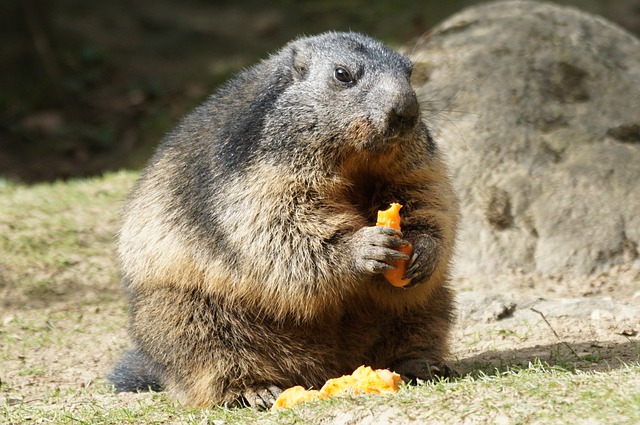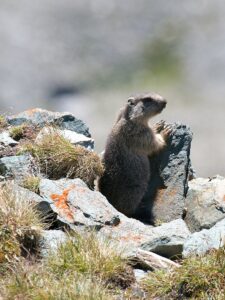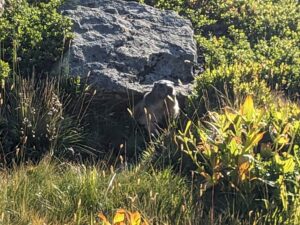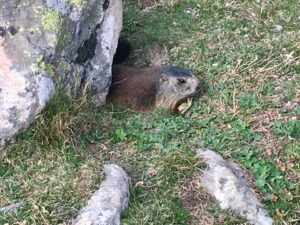Nine things you didn’t know about marmots

These large, ground-dwelling squirrels are a symbol of the Alps and other mountain ranges. They are easy to recognise from their cute, cuddly appearance, but how much do you know about everybody’s favourite mountain rodent?
There are fourteen different living species of marmot
Four extinct species have also been identified in the fossil record. The alpine marmot (Marmota marmota) only lives in Europe and is the only marmot you will see in the Alps. Marmot species found in North American mountains include the hoary marmot (Marmota caligata) and yellow-bellied marmot (Marmota flaviventris). Not all marmots live in the mountains. The groundhog (Marmota monax) is one of the lowland dwelling marmots.
Alpine marmots have their own marmot language
Marmots are recognisable by their shrill, whistling alarm calls. The alpine marmot uses a different call depending on the type of threat. A single, piercing whistle warns against a predator in the air – often an eagle. A series of whistles denotes danger on the ground. Studies of North American marmot species have not found the same correlation between threat type and alarm call.
They are monogamous and live in families
Marmots live in family groups with a distinct hierarchy. Each family is headed by a dominant male and female marmot, and only this couple are permitted to mate each year. It is the role of the dominant female to ensures that the rest follow this rule. The family has its own burrow which might be enlarged over successive generations until it becomes a complicated warren. All the marmots sleep together in the main sleeping chamber, the hibernaculum.
But sometimes they cheat
Different DNA studies have found that between 2.2% and 13% of marmot offspring have a father other than the dominant male, with young from the same litter sometimes having more than one father.

The families live in marmot colonies
Marmot families live together in a colony. Within the colony, each family has its own territory. Despite being neighbours, interactions between the families are limited and often hostile. Individuals in the family use the scent of their faeces to mark out the boundaries of their territory. In this way, it is clear which territory belongs to which group.
Marmots spend more time asleep than awake
Marmots hibernate for around two hundred days per year, losing around a third of their body mass. During this period, they live off their reserves of fat. They do not sleep constantly but have short periods of wakefulness which scientists believe help regulate their body temperatures. Newborn marmots spend the first months of their life racing to eat enough to survive their first hibernation.
Whistler was named after its marmots
Marmots are often known as whistlepigs or whistlers in Canada, due to their distinctive calls. In fact, the ski famous Canadian ski area of Whistler got its name from the calls of the marmots which live there. The original name was London Mountain, due to the rainy, foggy climate. As the resort developed, people thought the new name would be more attractive to tourists.
Marmots originated in North America 15 million years ago
After the Americas split from Eurasia around forty million years ago, rodent species evolved independently on both landmasses. Marmots first appeared around 15 million years ago in North America. Eurasian marmot species have evolved from marmots that crossed the Bering Strait into Eurasia around one million years ago.
Marmots have been used since ancient times to find gold
2500 years ago, Herodotus, the ancient Greek historian, wrote about large golden ‘ants’, bigger than foxes, which were used to find gold in the ancient Persian empire. Long dismissed as a fabrication, research from the mid-1990s suggests that Herodotus’s ants were golden marmots in what is now Pakistan. The ancient Persian word for marmot means mountain ant. The marmots there burrow in sandy, gold-bearing soil, collecting it on their fur. Historians now believe that the tribesmen used to extract gold from this sand that the marmots carried to the surface.
![]() If you want to see alpine wildlife in the wild, check out our hiking trips like the Tour du Mont Blanc, Chamonix Hiking Weeks, or guided day hikes. We can’t guarantee you’ll see marmots but on a multi-day trek we nearly always do. We also see plenty of other animals like the ibex, chamois, or griffon vulture.
If you want to see alpine wildlife in the wild, check out our hiking trips like the Tour du Mont Blanc, Chamonix Hiking Weeks, or guided day hikes. We can’t guarantee you’ll see marmots but on a multi-day trek we nearly always do. We also see plenty of other animals like the ibex, chamois, or griffon vulture.

